Detection of Crack Locations in Aluminum Alloy Structures Using FBG Sensors
Abstract
1. Introduction
2. Theoretical Performance
2.1. The Extraction of Strain Using Finite Element Modeling
2.2. The Reflected Spectra Simulations
2.3. Damage Feature—FWHM
2.4. Damage Feature—Spectral Difference
3. The Experimental Procedure
4. Experimental Results and Discussion
4.1. Results—The Strain Detected by DIC with FBG Spectra Variation
4.2. Results—Damage Location Measurement
5. Conclusions
Author Contributions
Funding
Conflicts of Interest
References
- Majumder, M.; Gangopadhyay, T.K.; Chakraborty, A.K.; Dasgupta, K.; Bhattacharya, D.K. Fibre Bragg gratings in structural health monitoring—Present status and applications. Sens. Actuators A Phys. 2008, 147, 150–164. [Google Scholar] [CrossRef]
- Miller, M.S.; Case, S.W.; Carman, G.P.; Schmid, C.A.; May, R.G.; Claus, R.O. Validation of axial strain transfer from a composite laminate to embedded optical fiber sensors. In Fiber Optic Smart Structures and Skins V; International Society for Optics and Photonics: Boston, MA, USA, 1993; Volume 1798, pp. 19–29. [Google Scholar]
- Park, C.; Peters, K. Optimization of embedded sensor placement for structural health monitoring of composite airframes. AIAA J. 2012, 50, 2536–2545. [Google Scholar] [CrossRef]
- Hill, K.O.; Meltz, G. Fiber Bragg grating technology fundamentals and overview. J. Lightwave Technol. 1997, 15, 1263–1276. [Google Scholar] [CrossRef]
- Pak, Y.E. Longitudinal shear transfer in fiber optic sensors. Smart Mater. Struct. 1992, 1, 57. [Google Scholar] [CrossRef]
- Peters, K.; Studer, M.; Botsis, J.; Iocco, A.; Limberger, H.; Salathé, R. Embedded optical fiber Bragg grating sensor in a nonuniform strain field: Measurements and simulations. Exp. Mech. 2001, 41, 19–28. [Google Scholar] [CrossRef]
- Zhang, W.; Zhang, M.; Wang, X.; Zhao, Y.; Jin, B.; Dai, W. The Analysis of FBG Central Wavelength Variation with Crack Propagation Based on a Self-Adaptive Multi-Peak Detection Algorithm. Sensors 2019, 19, 1056. [Google Scholar] [CrossRef] [PubMed]
- Takeda, S.; Okabe, Y.; Takeda, N. Delamination detection in CFRP laminates with embedded small-diameter fiber Bragg grating sensors. Compos. Part A Appl. Sci. Manuf. 2002, 33, 971–980. [Google Scholar] [CrossRef]
- Park, C.; Peters, K. Comparison of damage measures based on fiber Bragg grating spectra. Meas. Sci. Technol. 2012, 23, 025105. [Google Scholar] [CrossRef]
- Jin, X.; Yuan, S.; Chen, J. On crack propagation monitoring by using reflection spectra of AFBG and UFBG sensors. Sens. Actuators A Phys. 2019, 285, 491–500. [Google Scholar] [CrossRef]
- Liu, Q.; Qiao, X.; Jia, Z.A.; Fu, H. Spectra power and bandwidth of fiber Bragg grating under influence of gradient strain. Photonic Sens. 2016, 6, 333–338. [Google Scholar] [CrossRef]
- Pereira, G.F.; Mikkelsen, L.P.; McGugan, M. Crack detection in fibre reinforced plastic structures using embedded fibre bragg grating sensors: Theory, model development and experimental validation. PLoS ONE 2015, 10, e0141495. [Google Scholar] [CrossRef] [PubMed]
- Pereira, G.; Mikkelsen, L.P.; McGugan, M. Fibre Bragg Grating Sensor Signal Post-Processing Algorithm: Crack Growth Monitoring in Fibre Reinforced Plastic Structures. In Photoptics; Springer: Cham, Switzerland, 2015; pp. 63–80. [Google Scholar]
- Sutton, M.A.; Wolters, W.J.; Peters, W.H.; Ranson, W.F.; McNeill, S.R. Determination of displacements using an improved digital correlation method. Image Vis. Comput. 1983, 1, 133–139. [Google Scholar] [CrossRef]
- Zhang, W.; Cai, L.; Zhou, D.; Sun, F. In-situ microscopy testing of plasticity variation ahead of fatigue crack tip in AL2024-T3. Int. J. Fract. 2019, 216, 59–70. [Google Scholar] [CrossRef]
- Ferreira, M.D.C.; Venturini, W.S.; Hild, F. On the analysis of notched concrete beams: From measurement with digital image correlation to identification with boundary element method of a cohesive model. Eng. Fract. Mech. 2011, 78, 71–84. [Google Scholar] [CrossRef]
- Rice, J. Mechanics of Crack Tip Deformation and Extension by Fatigue. In Fatigue Crack Propagation; ASTM International: Providence, RI, USA, 1967. [Google Scholar]
- Borrego, L.P.; Ferreira, J.M.; Da Cruz, J.P.; Costa, J.M. Evaluation of overload effects on fatigue crack growth and closure. Eng. Fract. Mech. 2003, 70, 1379–1397. [Google Scholar] [CrossRef]
- Hackney, D.A.; Peters, K.J. Embedded fiber Bragg sensors for damage identification in sandwich composites after impact. In Smart Sensor Phenomena, Technology, Networks, and Systems 2010; International Society for Optics and Photonics: San Diego, CA, USA, 2010; Volume 7648, p. 76480B. [Google Scholar]
- Pippan, R.; Hohenwarter, A. Fatigue crack closure: A review of the physical phenomena. Fatigue Fract. Eng. Mater. Struct. 2017, 40, 471–495. [Google Scholar] [CrossRef] [PubMed]
- Yamada, M.; Sakuda, K. Analysis of almost-periodic distributed feedback slab waveguides via a fundamental matrix approach. Appl. Opt. 1987, 26, 3474–3478. [Google Scholar] [CrossRef] [PubMed]
- Degrieck, J.; De Waele, W.; Verleysen, P. Monitoring of fibre reinforced composites with embedded optical fibre Bragg sensors, with application to filament wound pressure vessels. NDT E Int. 2001, 34, 289–296. [Google Scholar] [CrossRef]
- Itakura, F. Minimum prediction residual principle applied to speech recognition. IEEE Trans. Acoust. Speech Signal Process. 1975, 23, 67–72. [Google Scholar] [CrossRef]
- Nežerka, V.; Antoš, J.; Litoš, J.; Tesárek, P.; Zeman, J. An integrated experimental-numerical study of the performance of lime-based mortars in masonry piers under eccentric loading. Constr. Build. Mater. 2016, 114, 913–924. [Google Scholar]

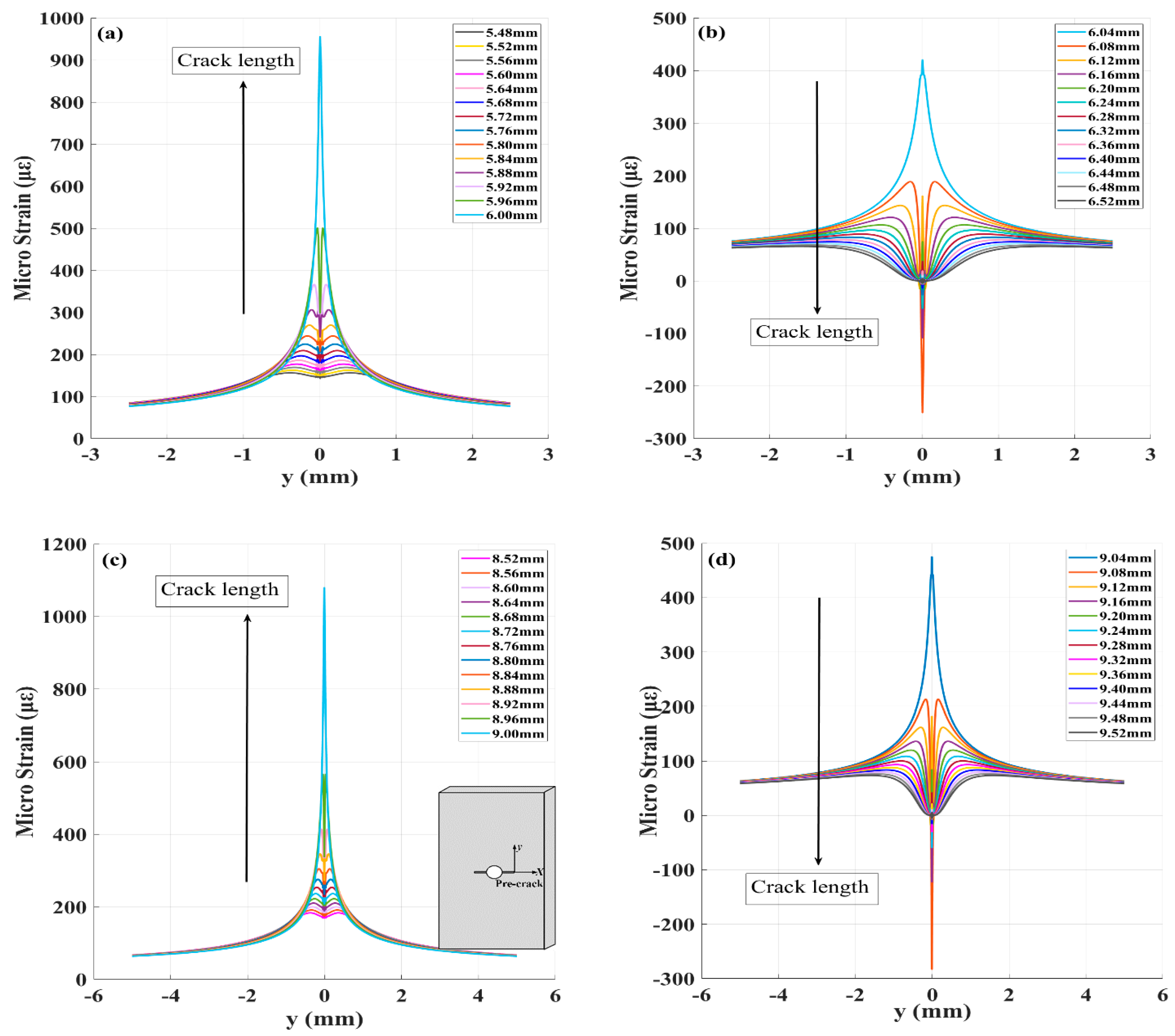

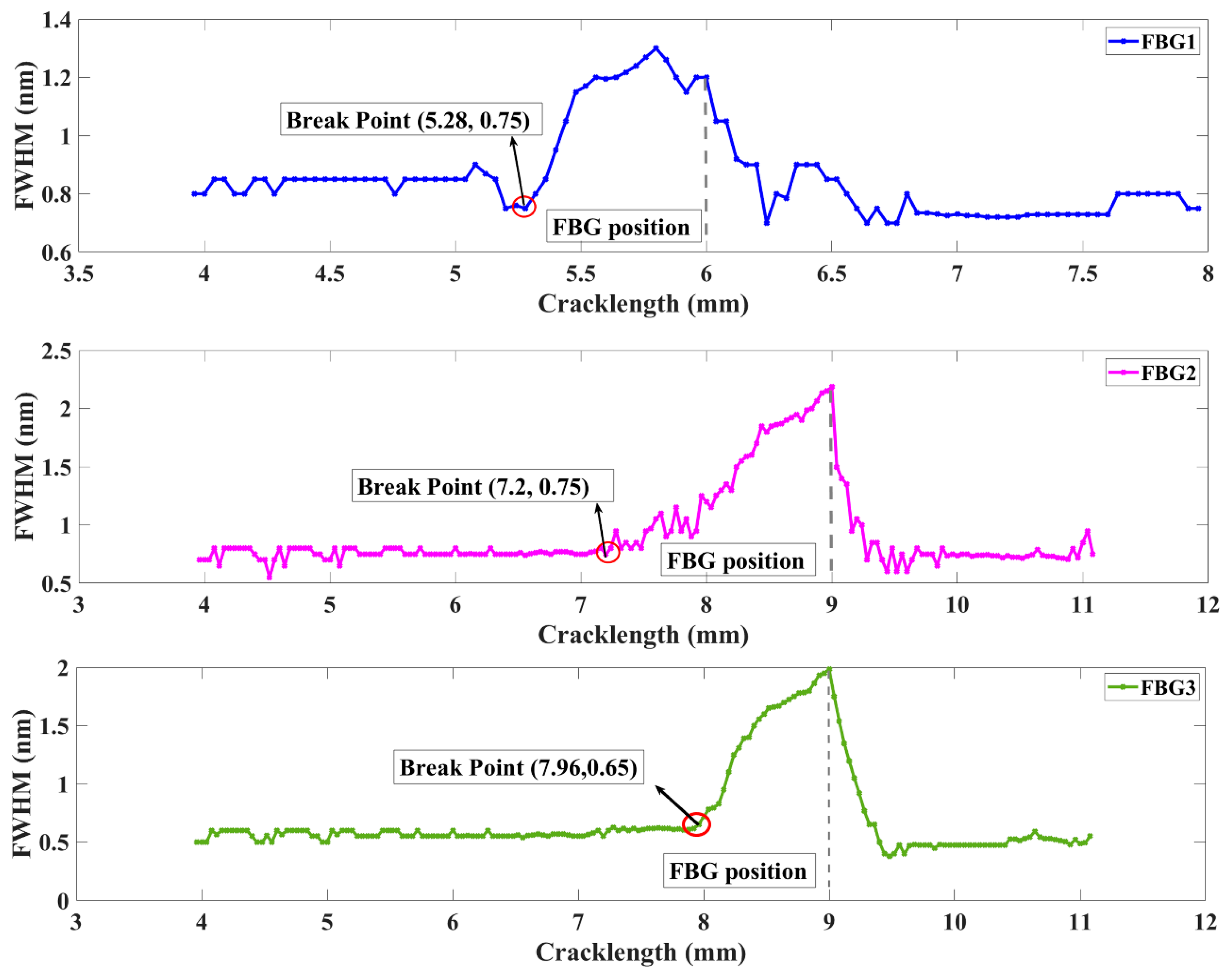
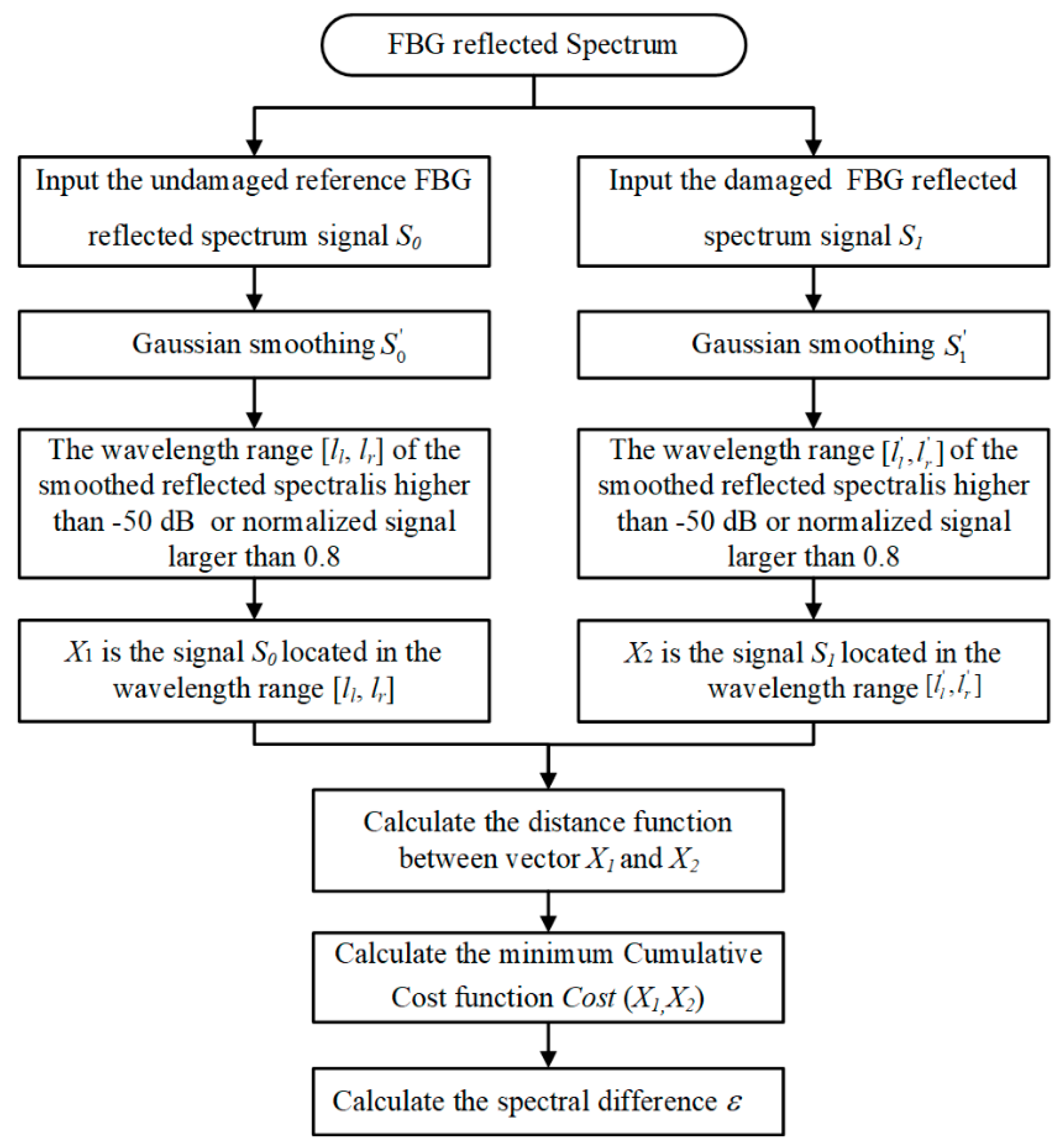
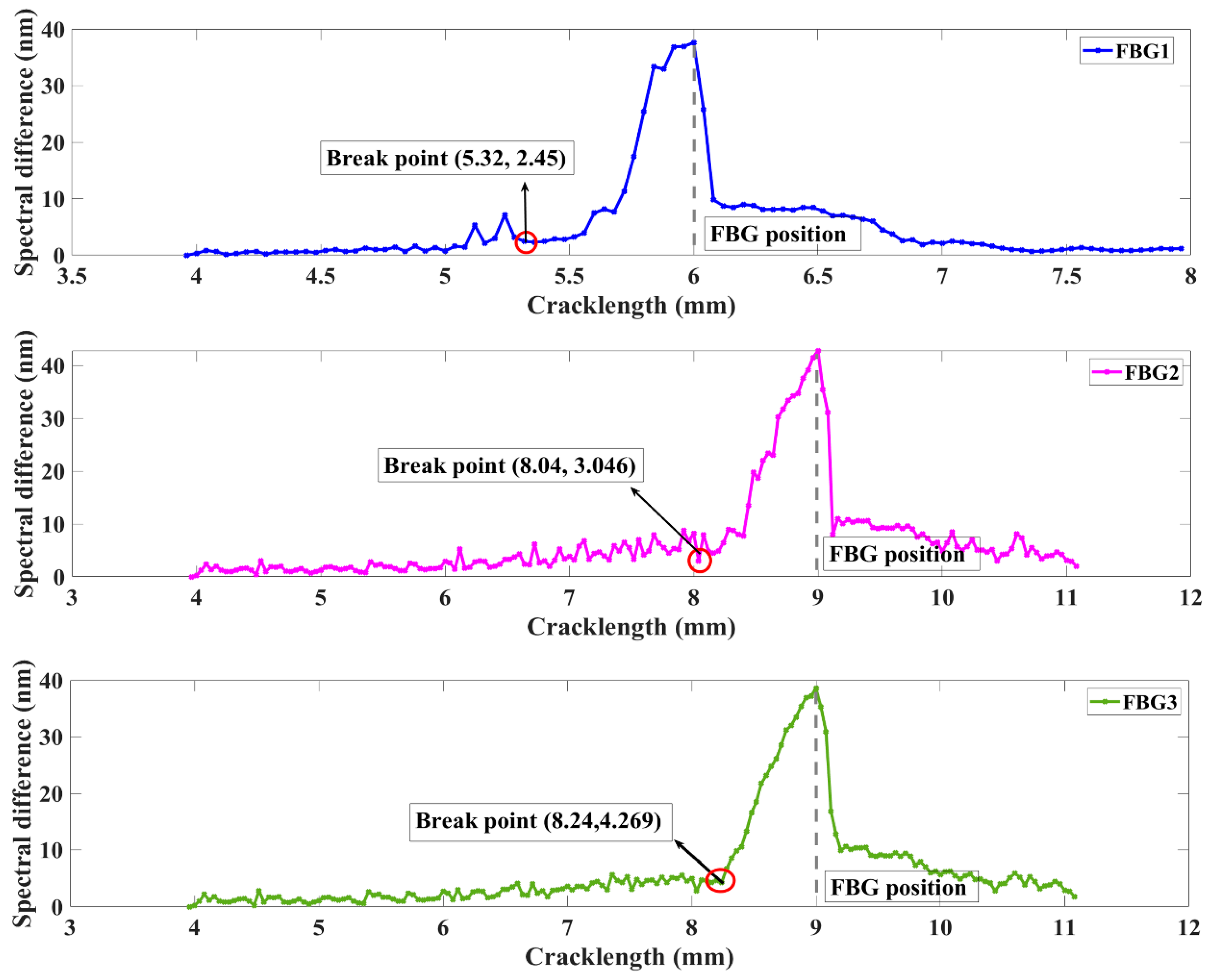
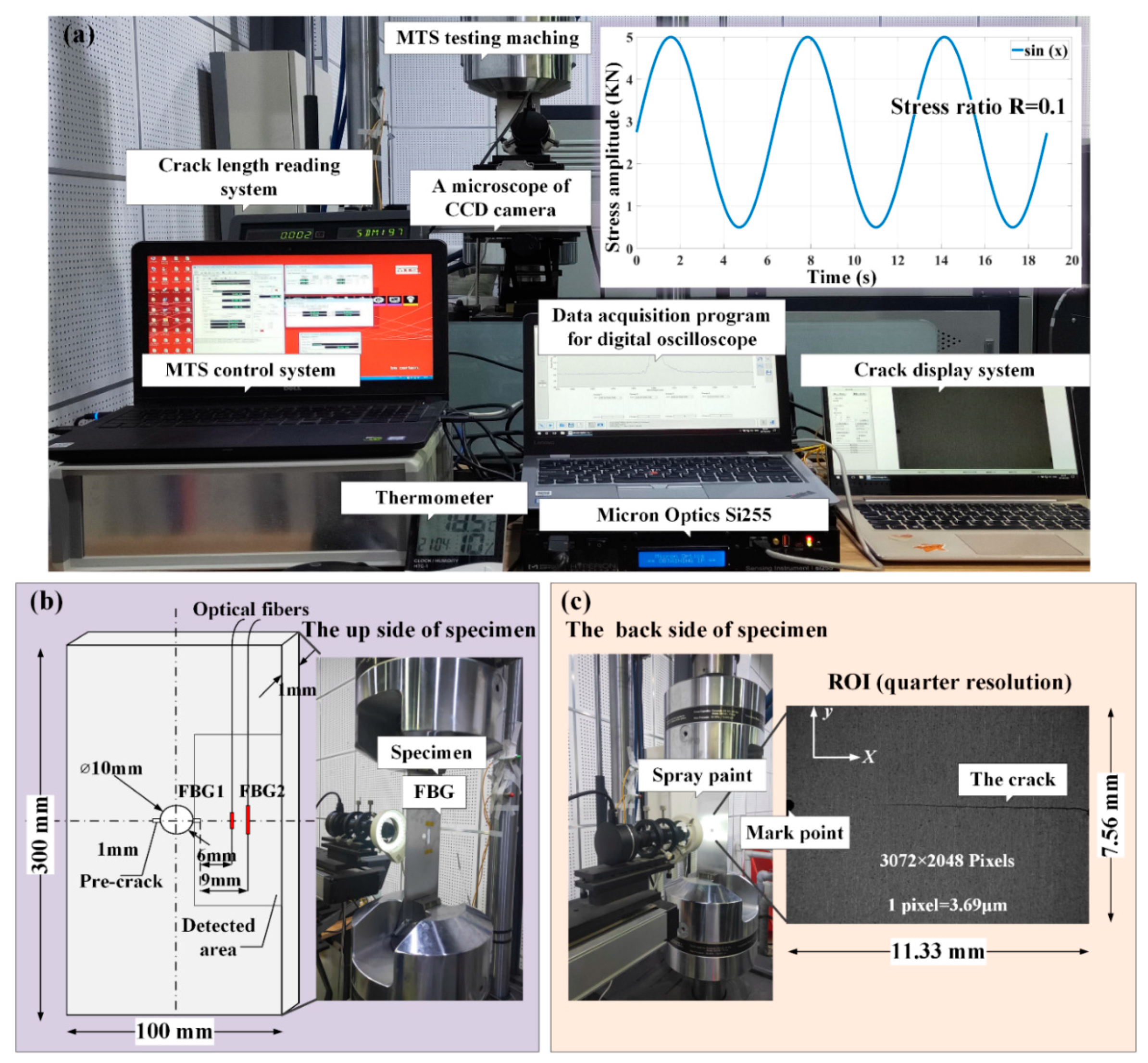

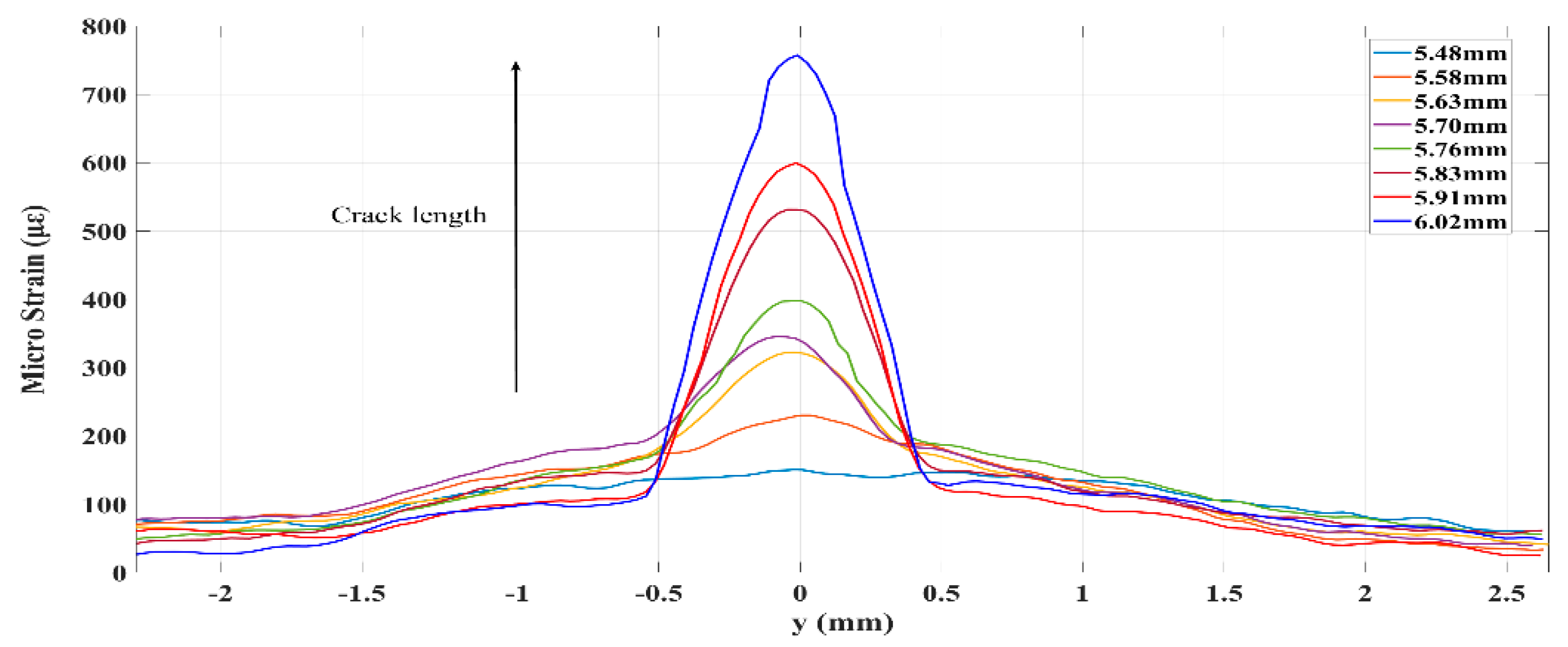
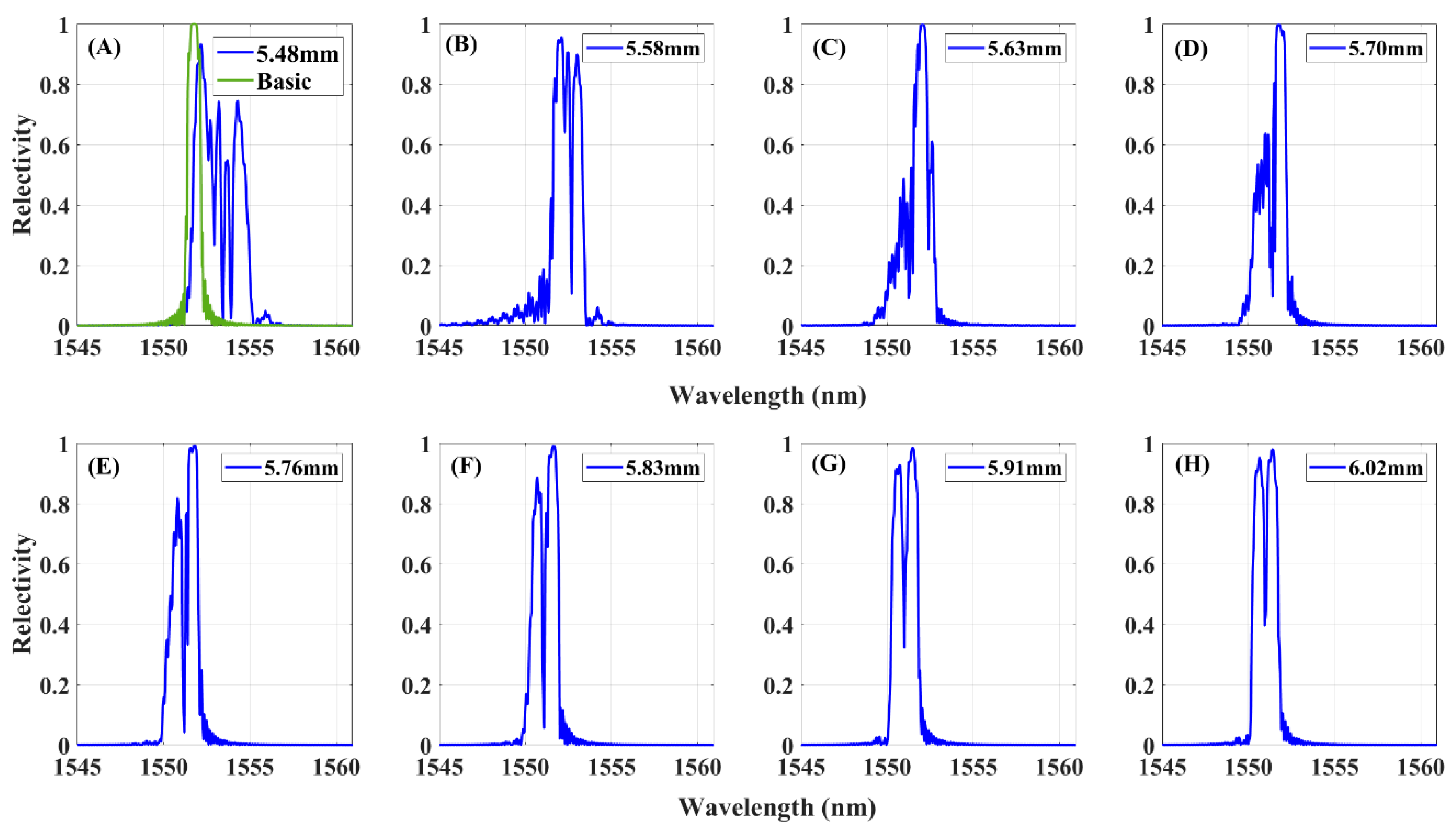
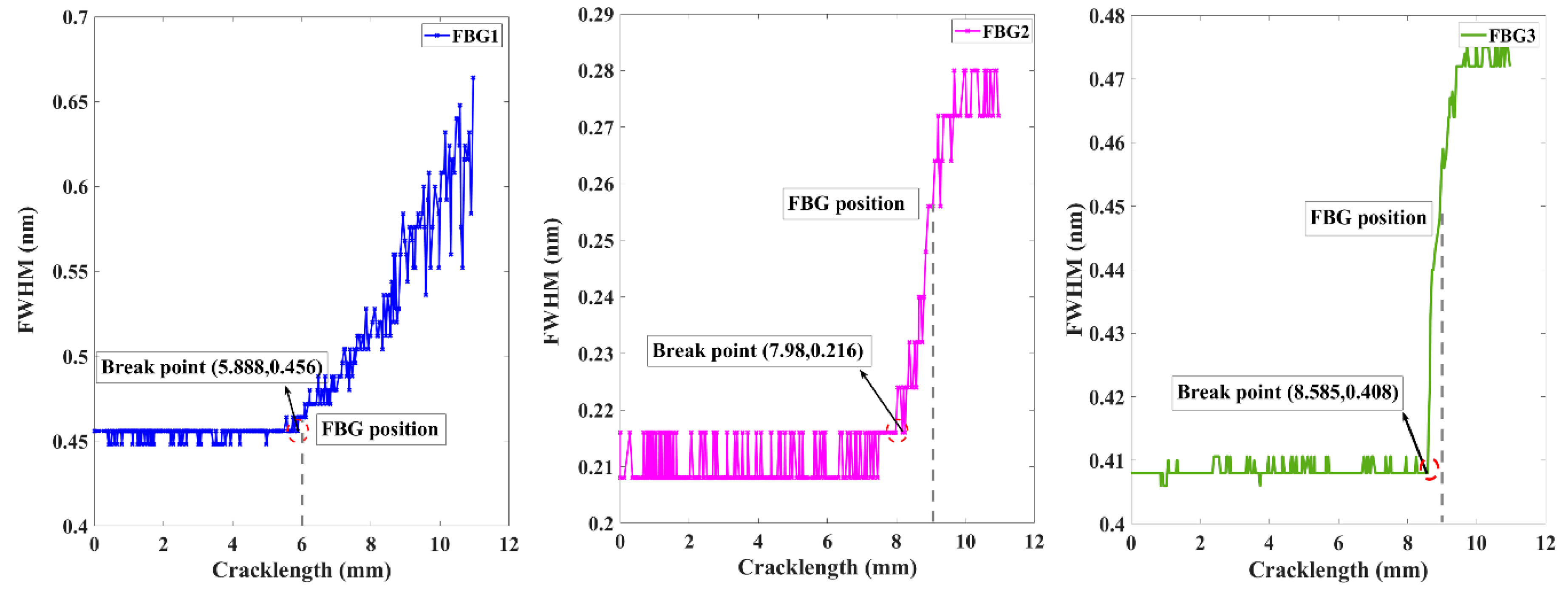
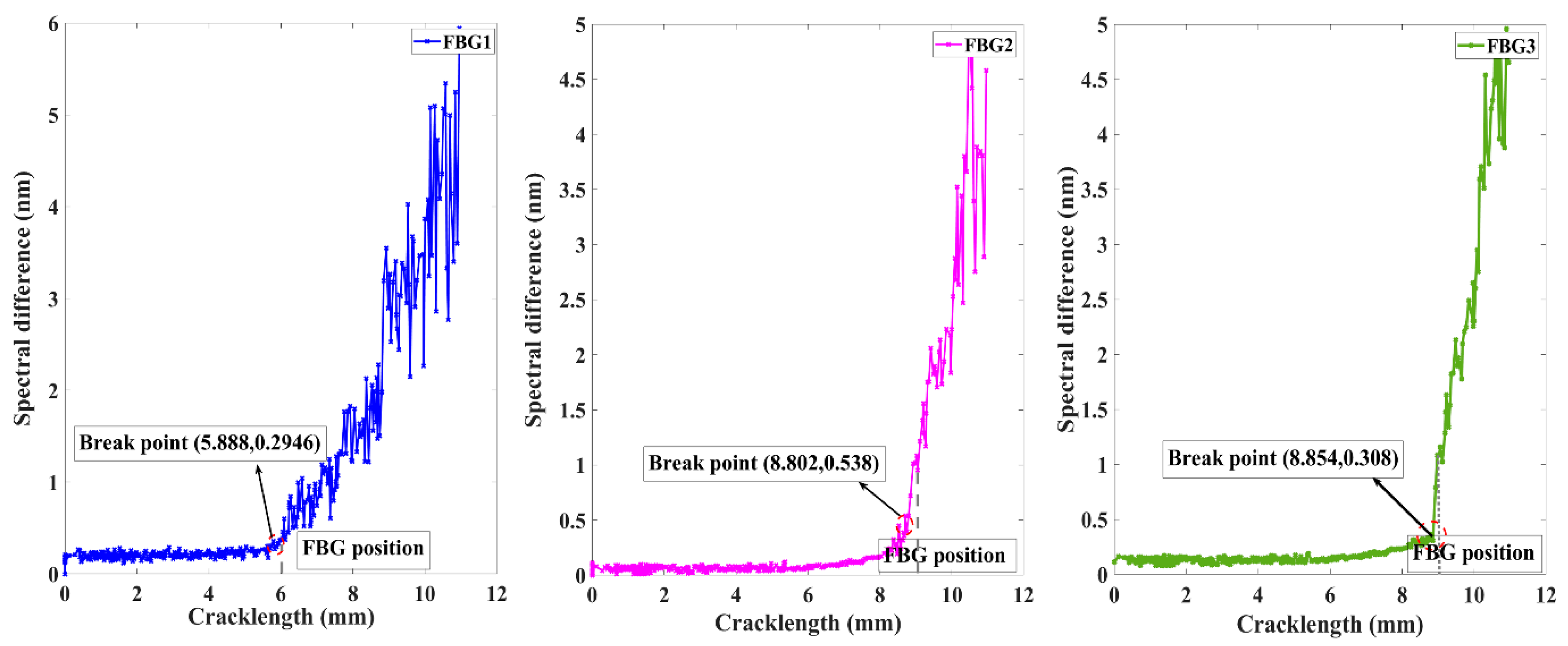
| Sensor Number | The Mechanical Properties of FBG Sensors | The Distance between FBGs and Original Crack-Tip (mm) | The Sensors on which Side of Specimen | ||||
|---|---|---|---|---|---|---|---|
| Grating Length (m) | Effective Index | Bragg Wavelength (nm) | Poisson’s Ratio (MPa) | Average Index Change | |||
| FBG1 | 0.0051 | 1.450 | 1550 | 0.17 | 2.0 × 10−4 | 6 | upside |
| FBG2 | 0.0100 | 1.458 | 1550 | 0.17 | 2.6 × 10−4 | 9 | upside |
| FBG3 | 0.0051 | 1.450 | 1550 | 0.17 | 2.0 × 10−4 | 9 | backside |
© 2020 by the authors. Licensee MDPI, Basel, Switzerland. This article is an open access article distributed under the terms and conditions of the Creative Commons Attribution (CC BY) license (http://creativecommons.org/licenses/by/4.0/).
Share and Cite
Zhang, W.; Zhang, M.; Lan, Y.; Zhao, Y.; Dai, W. Detection of Crack Locations in Aluminum Alloy Structures Using FBG Sensors. Sensors 2020, 20, 347. https://doi.org/10.3390/s20020347
Zhang W, Zhang M, Lan Y, Zhao Y, Dai W. Detection of Crack Locations in Aluminum Alloy Structures Using FBG Sensors. Sensors. 2020; 20(2):347. https://doi.org/10.3390/s20020347
Chicago/Turabian StyleZhang, Weifang, Meng Zhang, Yudong Lan, Yan Zhao, and Wei Dai. 2020. "Detection of Crack Locations in Aluminum Alloy Structures Using FBG Sensors" Sensors 20, no. 2: 347. https://doi.org/10.3390/s20020347
APA StyleZhang, W., Zhang, M., Lan, Y., Zhao, Y., & Dai, W. (2020). Detection of Crack Locations in Aluminum Alloy Structures Using FBG Sensors. Sensors, 20(2), 347. https://doi.org/10.3390/s20020347






